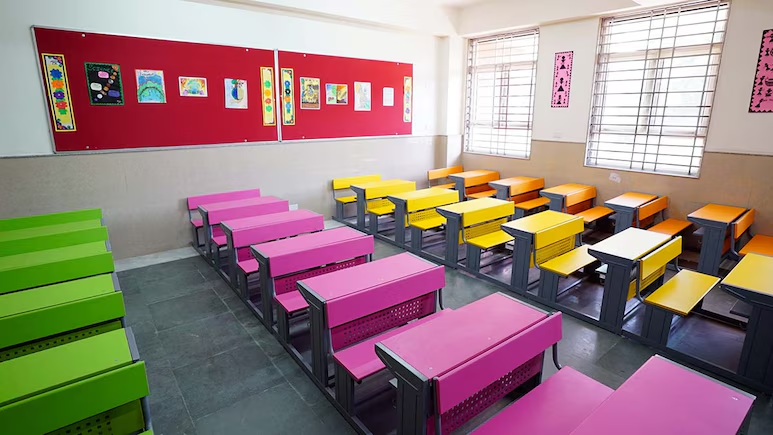
The year 2021 saw massive disruptions in the academic calendar and their impact fell upon students and kids. The massive shift from offline classroom learning to online has affected kids' learning patterns, students' mental and emotional well-being. According to a UNICEF study published early this year, said, online education is not an option for all as only one in four children has access to digital devices and internet connectivity.
According to a recent High School Moms (HSM) survey, 89 percent of students never started their camera because the online session was never interesting to them.
Stressing that students are missing out on community involvement, Abhishek Gupta, Founder and CEO of INACE and High School Moms said: “Students are missing out on community involvement and real-time learning and interaction in the classroom. There is a lack of face-to-face learning. Because you can't teach online the same way you can in person, it's critical to understand that our teachers must learn the art of presentation.”
“In an online class, teacher and student engagement is more important than ever before, and it necessitates a different set of skills,” Mr Gupta said adding that if teachers make an effort to modify their pedagogy to better suit the needs of their students, the gap can be narrowed.
“Lesson plans must be designed to accommodate students with short attention spans,” he added.
Take a look at the important studies and reports published during the year.
A UNESCO study titled “When Schools Shut: Gendered Impacts of COVID-19 School Closures” brings to the fore that girls and boys, young women and men were affected differently by school closures, depending on the context.
“At the peak of the COVID-19 pandemic, 1.6 billion students in 190 countries were affected by school closures. Not only did they lose access to education, but also to the myriad benefits of attending school, at an unparalleled scale,” said Stefania Giannini, UNESCO, Assistant Director-General for Education.
In another study by Save the Children said: “Children across the world have lost an average of 74 days of education or more than a third of the standard global 190-day school year each due to COVID-19-related school closures and lack of access to remote learning.” In total, an estimated 112 billion days of education have been lost altogether, with the world's poorest children being disproportionately affected, it said.
When asked how the learning gap can be narrowed amid school closures during Covid lockdown, Dr Niranjan Hiranandani, Provost, HSNC University said: “The advancements in technology have made the processes convenient for both educators and learners. However, teachers require a different skill-set and a fresh perspective towards pedagogy to bridge the learning gaps present in the digital space.”
The Government, Dr Hiranandani added, is also boosting initiatives like Digital India to make education accessible in every possible corner of the country. Besides, institutes are also implementing strategies that focus on improving learning for all students via an integrated approach that includes social, emotional, and academic learning, he added.
Global Education Monitoring Report (GEM), UNESCO
According to the Global Education Monitoring (GEM) report by UNESCO, climate change is not sufficiently integrated into the education framework, and only 50 per cent of the countries emphasise on the subject in their national-level laws, policies or teaching plans.
“References are mainly found at primary and secondary education levels (90 per cent). Fewer countries have frameworks to support climate change education in Technical and Vocational Education and Training System (TVET), higher education (70 per cent) and teacher training education (55 per cent),” it added.
National Coalition on the Education Emergency (NCEE) Report
The report -- "A Future at Stake – Guidelines and Principles to Resume and Renew Education" -- made a set of recommendations to help with reopening of schools at a time when India's 250 million children will return to schools after months amid devastating learning loss.
The report recommended focusing the education recovery effort on language and mathematics competencies and adopting a socio-emotional development approach. "This will allow students to make progress across multiple subjects. It means adjustment to the syllabus and timetable to give adequate time to these curricular areas," the report added.
Meanwhile, another report said every additional year of education in India increases a person's average income by about 6.7 per cent. The study was commissioned by the NGO, Population Foundation of India, on why the government needs to invest in young people's health, education and well-being.
UDISE Reports
Over 42 per cent of children in the country study in Hindi-medium schools, followed by English (26 per cent) and Bengali (6 per cent). The other two languages most prevalent in Indian classrooms as the medium of instruction are Marathi (5 per cent) and Tamil (2 per cent), according to the Unified District Information System for Education Plus (UDISE+) report released by the Education Ministry.
Another report said that more boys dropped out of school at the secondary level as well as in primary classes (1 to 5), while the number of girls dropping out of school in the upper primary classes (6-8) was higher than that of the boys in 2019-20.
